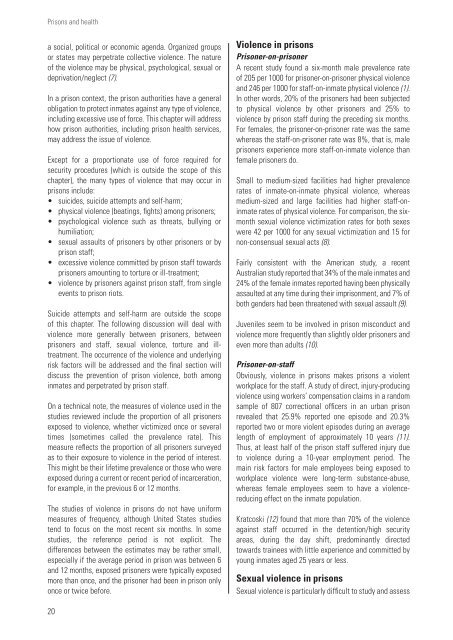Prisons
prisons-and-health
prisons-and-health
You also want an ePaper? Increase the reach of your titles
YUMPU automatically turns print PDFs into web optimized ePapers that Google loves.
<strong>Prisons</strong> and health<br />
a social, political or economic agenda. Organized groups<br />
or states may perpetrate collective violence. The nature<br />
of the violence may be physical, psychological, sexual or<br />
deprivation/neglect (7).<br />
In a prison context, the prison authorities have a general<br />
obligation to protect inmates against any type of violence,<br />
including excessive use of force. This chapter will address<br />
how prison authorities, including prison health services,<br />
may address the issue of violence.<br />
Except for a proportionate use of force required for<br />
security procedures (which is outside the scope of this<br />
chapter), the many types of violence that may occur in<br />
prisons include:<br />
• suicides, suicide attempts and self-harm;<br />
• physical violence (beatings, fights) among prisoners;<br />
• psychological violence such as threats, bullying or<br />
humiliation;<br />
• sexual assaults of prisoners by other prisoners or by<br />
prison staff;<br />
• excessive violence committed by prison staff towards<br />
prisoners amounting to torture or ill-treatment;<br />
• violence by prisoners against prison staff, from single<br />
events to prison riots.<br />
Suicide attempts and self-harm are outside the scope<br />
of this chapter. The following discussion will deal with<br />
violence more generally between prisoners, between<br />
prisoners and staff, sexual violence, torture and illtreatment.<br />
The occurrence of the violence and underlying<br />
risk factors will be addressed and the final section will<br />
discuss the prevention of prison violence, both among<br />
inmates and perpetrated by prison staff.<br />
On a technical note, the measures of violence used in the<br />
studies reviewed include the proportion of all prisoners<br />
exposed to violence, whether victimized once or several<br />
times (sometimes called the prevalence rate). This<br />
measure reflects the proportion of all prisoners surveyed<br />
as to their exposure to violence in the period of interest.<br />
This might be their lifetime prevalence or those who were<br />
exposed during a current or recent period of incarceration,<br />
for example, in the previous 6 or 12 months.<br />
The studies of violence in prisons do not have uniform<br />
measures of frequency, although United States studies<br />
tend to focus on the most recent six months. In some<br />
studies, the reference period is not explicit. The<br />
differences between the estimates may be rather small,<br />
especially if the average period in prison was between 6<br />
and 12 months, exposed prisoners were typically exposed<br />
more than once, and the prisoner had been in prison only<br />
once or twice before.<br />
Violence in prisons<br />
Prisoner-on-prisoner<br />
A recent study found a six-month male prevalence rate<br />
of 205 per 1000 for prisoner-on-prisoner physical violence<br />
and 246 per 1000 for staff-on-inmate physical violence (1).<br />
In other words, 20% of the prisoners had been subjected<br />
to physical violence by other prisoners and 25% to<br />
violence by prison staff during the preceding six months.<br />
For females, the prisoner-on-prisoner rate was the same<br />
whereas the staff-on-prisoner rate was 8%, that is, male<br />
prisoners experience more staff-on-inmate violence than<br />
female prisoners do.<br />
Small to medium-sized facilities had higher prevalence<br />
rates of inmate-on-inmate physical violence, whereas<br />
medium-sized and large facilities had higher staff-oninmate<br />
rates of physical violence. For comparison, the sixmonth<br />
sexual violence victimization rates for both sexes<br />
were 42 per 1000 for any sexual victimization and 15 for<br />
non-consensual sexual acts (8).<br />
Fairly consistent with the American study, a recent<br />
Australian study reported that 34% of the male inmates and<br />
24% of the female inmates reported having been physically<br />
assaulted at any time during their imprisonment, and 7% of<br />
both genders had been threatened with sexual assault (9).<br />
Juveniles seem to be involved in prison misconduct and<br />
violence more frequently than slightly older prisoners and<br />
even more than adults (10).<br />
Prisoner-on-staff<br />
Obviously, violence in prisons makes prisons a violent<br />
workplace for the staff. A study of direct, injury-producing<br />
violence using workers’ compensation claims in a random<br />
sample of 807 correctional officers in an urban prison<br />
revealed that 25.9% reported one episode and 20.3%<br />
reported two or more violent episodes during an average<br />
length of employment of approximately 10 years (11).<br />
Thus, at least half of the prison staff suffered injury due<br />
to violence during a 10-year employment period. The<br />
main risk factors for male employees being exposed to<br />
workplace violence were long-term substance-abuse,<br />
whereas female employees seem to have a violencereducing<br />
effect on the inmate population.<br />
Kratcoski (12) found that more than 70% of the violence<br />
against staff occurred in the detention/high security<br />
areas, during the day shift, predominantly directed<br />
towards trainees with little experience and committed by<br />
young inmates aged 25 years or less.<br />
Sexual violence in prisons<br />
Sexual violence is particularly difficult to study and assess<br />
20


